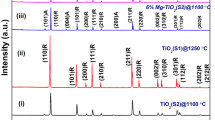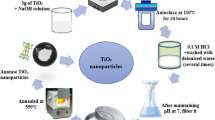Abstract
Due to its theoretically anticipated and practically observed above-room-temperature ferromagnetism and lengthy spin-coherence time, TiO2 has long been regarded as a viable candidate material for diluted magnetic semiconductors. Therefore, pure and (Sr, Co) co-doped TiO2 nanostructures of different compositions were synthesized via a simple hydrothermal method. X-ray diffraction analysis confirmed the formation of a high anatase phase with grain sizes ranging between 26 and 33 nm. The functional groups of these nanoparticles were observed through Fourier transform infrared spectroscopy analysis. Furthermore, Raman spectroscopy endorsed the single phase of the prepared nanostructures. UV–Vis spectroscopy was applied to study the behavior of absorption, which indicated an increase in band gap from 3.30 eV (pure TiO2) to 3.34 eV (5% co-doped TiO2). In addition, Ti3+ centers affiliated with oxygen vacancies have been described by electron spin resonance spectroscopy. Our findings provide comprehensive insight to tailor structural and optical properties of TiO2 nanostructure by Sr and Co co-doping. The (Sr, Co) co-doped TiO2 samples show ferromagnetic behavior. The saturation and remnant magnetizations (Ms and Mr) increased from (0.821 to 2.801) memu/g and (0.23 to 0.27 memu/g) while coercivity (Hc) enhanced from 50 to 75 Oe with an increase in the concentration of dopants in the TiO2 matrix. In (Sr, Co) co-doped TiO2 specimens, oxygen vacancies have been shown to be the principal cause of room-temperature ferromagnetism. The results reveal that the improved optical and magnetic characteristics of the (Sr, Co) co-doped TiO2 are closely linked to oxygen vacancy concentrations. The (Sr, Co)-doped TiO2 nanoparticles are suitable for spin-based electronics and optoelectronics-based industrial applications.







Similar content being viewed by others
References
D. Wöhrle, D. Meissner, Organic solar cells. Adv. Mater. 3(3), 129–138 (1991)
A.P. Zoombelt, M. Fonrodona, M.M. Wienk et al., Photovoltaic performance of an ultrasmall band gap polymer. Org. Lett. 11(4), 903–906 (2009)
S.E. Shaheen, C.J. Brabec, N.S. Sariciftci et al., 2.5% efficient organic plastic solar cells. Appl. Phys. Lett. 78(6), 841–843 (2001)
X. Yu, T.J. Marks, A. Facchetti, Metal oxides for optoelectronic applications. Nat. Mater. 15(4), 383–396 (2016)
A.O. Ibhadon, P. Fitzpatrick, Heterogeneous photocatalysis: recent advances and applications. Catalysts 3(1), 189–218 (2013)
R. Khan, S. Fashu, Structural, dielectric and magnetic properties of (Al, Ni) co-doped ZnO nanoparticles. J. Mater. Sci.: Mater. Electron. 28(5), 4333–4339 (2017)
J. Nataraj, P.Y. Bagali, M. Krishna et al., Development of silver doped titanium oxide thin films for gas sensor applications. Mater. Today 5(4), 10670–10680 (2018)
R. Khan, S. Fashu, Z.U. Rehman et al., Structure and magnetic properties of (Co, Mn) co-doped ZnO diluted magnetic semiconductor nanoparticles. J. Mater. Sci.: Mater. Electron. 29(1), 32–37 (2018)
L.-H. Xu, D.S. Patil, J. Yang et al., Metal oxide nanostructures: synthesis, properties, and applications. J. Nanotechnol. (2015). https://doi.org/10.1155/2015/135715
M. Zubair, A. Khan, T. Hua et al., Oxygen vacancies induced room temperature ferromagnetism and enhanced dielectric properties in Co and Mn co-doped ZnO nanoparticles. J. Mater. Sci.: Mater. Electron. 32(7), 9463–9474 (2021)
N. Coleman Jr., Synthesis and characterization of metal doped titanium dioxide, transition metalphosphides, sulfides and thiophosphates for photocatalysis and energy applications, Dissertation, University of Iowa. https://doi.org/10.17077/etd.61b6fq5m (2016)
K. Rajwali, F. Ming-Hu, Dielectric and magnetic properties of (Zn, Co) co-doped SnO2 nanoparticles. Chin. Phys. B 24(12), 127803 (2015)
M.G. Kulkarni, A.K. Dalai, Waste cooking oil an economical source for biodiesel: a review. Ind. Eng. Chem. Res. 45(9), 2901–2913 (2006)
R. Khan, S. Fashu, Y. Zaman, Magnetic and dielectric properties of (Co, Zn) co-doped SnO2 diluted magnetic semiconducting nanoparticles. J. Mater. Sci.: Mater. Electron. 27(6), 5960–5966 (2016)
K. Nakata, A. Fujishima, TiO2 photocatalysis: design and applications. J. Photochem. Photobiol. C 13(3), 169–189 (2012)
H. Tang, K. Prasad, R. Sanjines et al., Electrical and optical properties of TiO2 anatase thin films. J. Appl. Phys. 75(4), 2042–2047 (1994)
X. Chen, S.S. Mao, Titanium dioxide nanomaterials: synthesis, properties, modifications, and applications. Chem. Rev. 107(7), 2891–2959 (2007)
M. Matsuoka, M. Kitano, M. Takeuchi et al., Photocatalysis for new energy production: recent advances in photocatalytic water splitting reactions for hydrogen production. Catal. Today 122(1–2), 51–61 (2007)
R. Asahi, T. Morikawa, T. Ohwaki et al., Visible-light photocatalysis in nitrogen-doped titanium oxides. Science 293(5528), 269–271 (2001)
A. Di Paola, M. Bellardita, L. Palmisano, Brookite, the least known TiO2 photocatalyst. Catalysts 3(1), 36–73 (2013)
Z. Wu, D. Lee, M.F. Rubner et al., Structural color in porous, superhydrophilic, and self-cleaning SiO2/TiO2 bragg stacks. Small 3(8), 1445–1451 (2007)
N. Rajamanickam, S. Kanmani, S. Rajashabala et al., Influence of Sr doping on structural, optical and magnetic properties of TiO2 nanoparticles. Mater. Lett. 161, 520–522 (2015)
Y. Kubota, T. Shuin, C. Kawasaki et al., Photokilling of T-24 human bladder cancer cells with titanium dioxide. Br. J. Cancer 70(6), 1107–1111 (1994)
S.N. Hoseini, A.K. Pirzaman, M.A. Aroon et al., Photocatalytic degradation of 2,4-dichlorophenol by co-doped TiO2 (Co/TiO2) nanoparticles and Co/TiO2 containing mixed matrix membranes. J. Water Process Eng. 17, 124–134 (2017)
M.M. Khan, S. Kumar, M.N. Khan et al., Microstructure and blueshift in optical band gap of nanocrystalline AlxZn1−xO thin films. J. Lumin. 155, 275–281 (2014)
W. Asghar, I.A. Qazi, H. Ilyas et al., Comparative solid phase photocatalytic degradation of polythene films with doped and undoped TiO2 nanoparticles. J. Nanomater. (2011). https://doi.org/10.1155/2011/461930
S. Mugundan, B. Rajamannan, G. Viruthagiri et al., Synthesis and characterization of undoped and cobalt-doped TiO2 nanoparticles via sol–gel technique. Appl. Nanosci. 5(4), 449–456 (2015)
B. Choudhury, A. Choudhury, Luminescence characteristics of cobalt doped TiO2 nanoparticles. J. Lumin. 132(1), 178–184 (2012)
R.D. Chekuri, S.R. Tirukkovalluri, Synthesis of cobalt doped titania nano material assisted by gemini surfactant: characterization and application in degradation of acid red under visible light irradiation. S. Afr. J. Chem. Eng. 24, 183–195 (2017)
G.D. Venkatasubbu, S. Ramasamy, V. Ramakrishnan et al., Folate targeted pegylated titanium dioxide nanoparticles as a nanocarrier for targeted paclitaxel drug delivery. Adv. Powder Technol. 24(6), 947–954 (2013)
G. Yang, Z. Jiang, H. Shi et al., Preparation of highly visible-light active n-doped TiO2 photocatalyst. J. Mater. Chem. 20(25), 5301–5309 (2010)
A.M. Abdullah, N.J. Al-Thani, K. Tawbi et al., Carbon/nitrogen-doped TiO2: new synthesis route, characterization and application for phenol degradation. Arab. J. Chem. 9(2), 229–237 (2016)
A.M. Toufiq, F. Wang, Q. Li et al., Hydrothermal synthesis of MnO2 nanowires: structural characterizations, optical and magnetic properties. Appl. Phys. A 116(3), 1127–1132 (2014)
H. Lin, C. Huang, W. Li et al., Size dependency of nanocrystalline TiO2 on its optical property and photocatalytic reactivity exemplified by 2-chlorophenol. Appl. Catal. B 68(1–2), 1–11 (2006)
J.-P. Rino, N. Studart, Structural correlations in titanium dioxide. Phys. Rev. B 59(10), 6643 (1999)
P. Bhange, S. Awate, R. Gholap et al., Photocatalytic degradation of methylene blue on Sn-doped titania nanoparticles synthesized by solution combustion route. Mater. Res. Bull. 76, 264–272 (2016)
X.-h Lu, X. Huang, S.-l Xie et al., Facile electrochemical synthesis of single crystalline CeO2 octahedrons and their optical properties. Langmuir 26(10), 7569–7573 (2010)
R. Hoffmann, A chemical and theoretical way to look at bonding on surfaces. Rev. Mod. Phys. 60(3), 601–628 (1988)
A. Lund, M. Shiotani, S. Shimada, Principles and Applications of ESR Spectroscopy (Springer Science & Business Media, Dordrecht, 2011)
S. Zhou, E. Čižmár, K. Potzger et al., Origin of magnetic moments in defective TiO2 single crystals. Phys. Rev. B 79(11), 113201 (2009)
D.C. Hurum, K.A. Gray, T. Rajh et al., Recombination pathways in the degussa p25 formulation of TiO2: surface versus lattice mechanisms. J. Phys. Chem. B 109(2), 977–980 (2005)
S.B. Ogale, Dilute doping, defects, and ferromagnetism in metal oxide systems. Adv. Mater. 22(29), 3125–3155 (2010)
H. Peng, J. Li, S.-S. Li et al., Possible origin of ferromagnetism in undoped anatase TiO2. Phys. Rev. B 79(9), 092411 (2009)
S.D. Yoon, Y. Chen, A. Yang et al., Oxygen-defect-induced magnetism to 880 k in semiconducting anatase TiO2−δ films. J. Phys.: Condens. Matter 18(27), L355 (2006)
R. Khan, K. Althubeiti, Zulfiqar et al., Structure and magnetic properties of (Co, Ce) co-doped ZnO-based diluted magnetic semiconductor nanoparticles. J. Mater. Sci.: Mater. Electron 32, 24394–24400 (2021)
R. Khan, V. Tirth, A. Ali, et al., Effect of Sn-doping on the structural, optical, dielectric and magnetic properties of ZnO nanoparticles for spintronics applications. J. Mater. Sci.: Mater. Electron. 32, 21631–21642 (2021)
Acknowledgements
We would like to thank Taif University Researchers Supporting Project Number (TURSP-2020/267), Taif University, Taif, Saudi Arabia.
Author information
Authors and Affiliations
Corresponding authors
Additional information
Publisher's Note
Springer Nature remains neutral with regard to jurisdictional claims in published maps and institutional affiliations.
Rights and permissions
About this article
Cite this article
Rahman, M., Saqib, M., Althubeiti, K. et al. Effect of Sr and Co co-doping on the TiO2-diluted magnetic semiconductor for spintronic applications. J Mater Sci: Mater Electron 32, 28718–28729 (2021). https://doi.org/10.1007/s10854-021-07253-y
Received:
Accepted:
Published:
Issue Date:
DOI: https://doi.org/10.1007/s10854-021-07253-y




